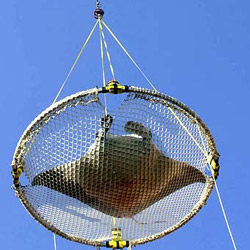
The True Percula Clownfish is the fish most people picture when they imagine a marine aquarium. With their bright orange body color, divided by bands of elegant white outlined in black, Amphiprion percula is the essence of beauty. However, it is the famous symbiotic relationship the True Percula Clownfish has with various anemones that truly captures the imagination of most aquarists. In the wild, True Percula Clownfish is commonly associated with anemones such as Heteractis magnifica or Stichodactyla mertensii. However, in the home aquarium the True Percula Clownfish can do fine without an anemone partner. The True Percula Clownfish is not for the inexperienced, which poses a challenge for many new hobbyists. Percula Clownfish is often confused for the much easier to keep and more drably colored Ocellaris Clownfish. Therefore, care needs to be taken in choosing the appropriate clownfish for your home aquarium. The Percula Clownfish also has a thicker black outline to its white body stripes. Native to reefs across Oceania, the Indo-Pacific, and off the coast of Australia, the True Percula Clownfish is also known as the Clown Anemonefish. In the wild, this member of the Pomacentridae family grows to about 4-1/2 inches; however, captive specimens rarely exceed 3-1/2 inches in length. In the home aquarium, the True Percula Clownfish requires an aquarium of at least 30 gallons with a fair amount of live rock. Since the True Percula Clownfish is an omnivore, it requires a varied diet consisting of both meaty foods and herbivore preparations. Though not as hardy as the Ocellaris Clownfish, once acclimated to your system and eating, the True Percula Clownfish is a good candidate for reef aquariums. If already paired, the female Percula Clownfish is the larger fish. The Percula Clownfish, like several other clownfish, can be bred in the home aquarium, and is one of the most common “starter” fish for saltwater breeders. Quick Stats: is an awesome addition to your fish tank! We’re updating this profile so check back again but in the meantime, if you have any questions, please ask in our forum! Click here to start asking your question! |





{ 1 comment… read it below or add one }
don’t get these confused with the ocellaris clownfish. These have more of a black marking to their bodies. I find them to be a bit more aggressive than ocellaris. Stunning fish. Goes great with your anemone but it’s not necessary to have an anemone if your tank does not support one.